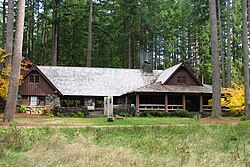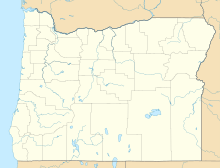Silver Falls State Park
| Silver Falls State Park | |
|---|---|

South Falls
|
|
| Type | Public, state |
| Location | Marion County, Oregon |
| Nearest city | Silverton |
| Coordinates | 44°51′04″N 122°38′46″W / 44.8512332°N 122.6461975°WCoordinates: 44°51′04″N 122°38′46″W / 44.8512332°N 122.6461975°W |
| Operated by | Oregon Parks and Recreation Department |
|
Silver Falls State Park Concession Building Area
|
|

Silver Falls Lodge
|
|
| Nearest city | Sublimity, Oregon |
|---|---|
| Built | 1934 |
| Architect | J. Elwood Isted |
| NRHP Reference # | |
|
Silver Creek Youth Camp – Silver Falls State Park
|
|
| Nearest city | Sublimity, Oregon |
| Coordinates | 44°51′23″N 122°36′31″W / 44.85639°N 122.60861°W |
| Built | 1936 |
| Architect | Keith R. Maguire, Jr. |
| Architectural style | National Park Service rustic |
| NRHP Reference # | 02000673 |
| Added to NRHP | June 20, 2002 |
| Added to NRHP | June 30, 1983 |
Silver Falls State Park is a state park in the U.S. state of Oregon, located near Silverton, about 20 miles (32 km) east-southeast of Salem. It is the largest state park in Oregon with an area of more than 9,000 acres (36 km2), and it includes more than 24 miles (39 km) of walking trails, 14 miles (23 km) of horse trails, and a 4-mile (6.4 km) bike path. Its 8.7-mile (14.0 km) Canyon Trail/Trail of Ten Falls runs along the banks of Silver Creek and by ten waterfalls, from which the park received its name. Four of the ten falls have an amphitheater-like surrounding that allows the trail to pass behind the flow of the falls. The Silver Falls State Park Concession Building Area and the Silver Creek Youth Camp-Silver Falls State Park are separately listed on the U.S. National Register of Historic Places.
The park's most visited waterfall is South Falls, a 177-foot (54 m) cascade. Remote Double Falls, however, is listed as the highest waterfall in the park, plunging 178 feet (54 m) in a small tributary side canyon deep within the Silver Creek Canyon.
Silver Falls City formed in 1888 and was primarily a logging community with a few homesteaders, and the area was extensively logged. The small lumber town of Silver Falls City sat atop the South Falls, and as the land was cleared, a local entrepreneur sold admission to the Falls area, with attractions such as pushing cars over the falls and even hosting a stunt with a daredevil riding over in a canoe.
By 1900 a Silverton photographer, June D. Drake, began to campaign for park status, using his photographs of the falls to gain support. (Drake Falls was later named for him.) In 1926, however, an inspector for the National Park Service rejected the area for park status because of a proliferation of unattractive stumps after years of logging.
...
Wikipedia

